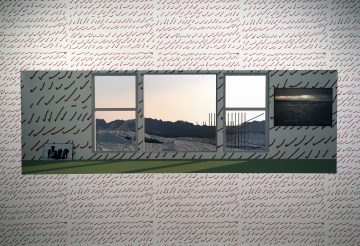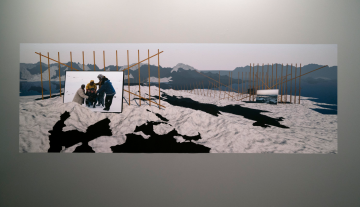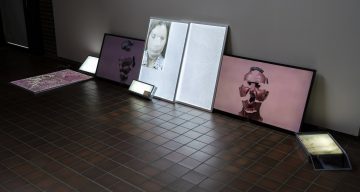
Together Otherwise, 2018. Reproduced with permission from the artist.
“[…] Continually thinking through my own experiences helps validate others living with mental illness experiences. It is about inclusivity, saying you aren’t alone in this, I am here with you and this is how I am working through it and thinking about it”.
Online platforms have become increasingly popular tools for artists. Apps and websites like Instagram, Tumblr, Vimeo among others allow for work to be uploaded and shared at various stages of development. This can foster a sense of community, support and help promote newer-career level artists’ work. Online communities can also encourage conversations and break down barriers for those who may be members of marginalized groups. The use of these platforms can create a digital identity; a snapshot of your work, your world and what you represent. Artist Brad Necyk shared with us here at Digital Tattoo some of his own insights and thoughts on online presence.
The intersections between art, digital presence and marginalization are at the forefront of Necyk’s work. Currently based out of Edmonton, AB, Necyk acts as an interdisciplinary researcher, combining his fine arts practice with his work in psychiatry. In a thoughtful manner, his work touches on mental and physical health; by giving illness agency it in turn can be exposed and thus destigmatized. Necyk works within the digital realm, discussing and animating thoughtful iterations of identity and meaning making. His work is often mixed-media: combining painting, photography, digital renders, film and narrative.
I read you’re currently completing work towards your PhD in Psychiatry at the University of Alberta. Could you begin by telling us a bit about yourself and your practice and how your location plays role?
Currently, I am in the final stages of my doctoral studies in Psychiatry at the University of Alberta in Edmonton. Over these years, I have been exploring the lived experience of illness (organ transplantation, cancer, suicide, and mental illness) directly with people living with illness and explore these experiences through creative means—visual, narrative, film, and theatre. These areas of research have been the primary focus of my larger artistic practice, however, I have been working on projects on the environment in relation to the Anthropocene. Over the past few years, I have been fortunate enough to share my work across Canada and internationally through exhibitions, film screenings, artist residencies, and public lectures. As my doctoral studies are coming to an end I am moving into a project that is looking at the psychological effects of growing up in the Anthropocene, something my two daughters will have to do. Further, I am working to make contributions to the emerging field of research-creation, a mode of scholarly research that puts emphasis on and creates space for the creative act to be a site of knowledge generation and not simply a mode of expression.
Storing Otherwise, 2018. Reproduced with permission of the artist.
I have noticed that you are an active user of online platforms, including Instagram and Vimeo. What benefits or drawbacks do you see social media platforms providing for your work, specifically around the destigmatization of illness?
First, I treat my Instagram account as a window into my studio practice. The instant I get close to an image I render it out and put it Instagram. It acts as a release to share what I am thinking about at that exact moment. I have always considered each artwork to be my philosophy of everything at that moment. It is a mirror to wherever I am in my life at that point—all the love, frustration, curiosity, and pressing thoughts and affects. And being able to share that has become part of my practice. After the image is posted I continue to work and rework the images and often arrive somewhere far off from the initial shared image and those end up on my website and in exhibitions. Instagram is a testing ground to see the activity in my practice, not the final products. A cell phone screen and the roughly 1.5-inch size of the image on the screen simply can’t do it justice. Further, I have never considered my practice to be about producing singular works—it isn’t about masterpieces, that is not what I am trying to do—but, instead, I am trying to create an active practice of thought and curiosity that is a journey, not an endpoint. Everything is in flux and constant reworking and often works never end. Because of this, a platform like Instagram fits this model well as it is simply a touch down point to where I am at that moment and not focused on finished works.
Second, a platform like Instagram can connect me to communities that are far out of the limited reach of my home city of Edmonton. Hashtagging #mentalhealth, #mentalillness, and #psychiatry places my work within a different visual context, hopefully catching viewers as a unique thought or take on the subject. Over the years I have heard wonderful comments from people all over the world, people that might never come to an art exhibition to see the work, but who have been engaged through a digital sharing platform. I am never sure what, if any, future opportunities might come from these new connections but it at least places my work in a larger discussion of inclusive and safe dialogue about a heavily stigmatized subject.

Dwelling Otherwise, 2018. Reproduced with the permission of the artist.
“The instant I get close to an image I render it out and put it Instagram. It acts as a release to share what I am thinking about at that exact moment. I have always considered each artwork to be my philosophy of everything at that moment. It is a mirror to where ever I am in my life at that point—all the love, frustration, curiosity, and pressing thoughts and affects. And being able to share that has become part of my practice”.

Hope Otherwise, 2018/ Reproduced with the permission of the artist.
You often use images of your patients in your work, however they are normally distorted or obscured. Like in the videos for Head and Neck Cancer, and the composites Together Otherwise and Hope Otherwise. Was this a conscious decision to protect their privacy?
First, distortion is something I have in both my digital (3D-renders, animations, videos, photographs, and sound) and analog (drawing and painting) practices. It is about blurring the boundaries between these two realms, with the digital work taking on, often, a painterly quality. Further, within the digital works, the boundaries between a completely fabricated image in a 3D-render might look very close to the digital manipulations of videos and photographs of the real world and people. It created an aesthetic through-line between all of the bodies of work to tie together these disparate mediums.
Second, as for protecting privacy, that has not been a concern because I have research ethics approval and consent to take these images. The heavy digital manipulation is there for aesthetic and conceptual reasons, each technique exploring some facet of the person’s experience with illness.
Waiting Room #1 and #2, from Necyk’s Head and Neck Cancer series, 2017. Reproduced with permission from the artist.
What role do you believe digital platforms perform in the discussion of illness advocacy and education?
I have received comments and direct messages that share their appreciation for continued work in the area and openness to sharing my story about living with mental illness. Seeing new work continually thinking through my own experiences helps validate others living with mental illness experiences. It is about inclusivity, saying you aren’t alone in this, I am here with you and this is how I am working through it and thinking about it.

Installation view, September 2018, FAB Gallery, Edmonton, AB. Reproduced with permission from the artist.
Is there anything else you would like to add about how your work intersects with digital identity that the questions above did not cover?
I consider my website and Instagram as my primary spaces to share work and thoughts and not always waiting for exhibitions to come along to share it. They are spaces to share the energy and speed that my practice works. While it is rare for me not to have a physical exhibition always running throughout the year, these platforms provide an immediate lens into my practice that exhibition curation can sometimes cloud. And, as I said, it is the practice and not the final works that I am always most interested in, both personally and with other artists’ practices.
Out of Mind, 2018. Reproduced with permission from the artist.
Find more information about Brad Necyk work here on his website: www.bradnecyk.com
Follow him on: Instagram, Twitter, and Vimeo
Find here a list of his upcoming exhibitions in 2019:
2019 TBD. NYA Gallery. New York City, NY — March
2019 Dyscorpia. Enterprise Square Gallery. Edmonton, AB — April
2019 TBD. Mile Zero. Edmonton, AB — May
2019 TBD. Scott Gallery. Edmonton, AB (Solo) — May
2019 TBD. Art Gallery of Alberta. Edmonton, AB — July
2019 TBD. The Ou Gallery. Duncan, BC (Solo) — August

